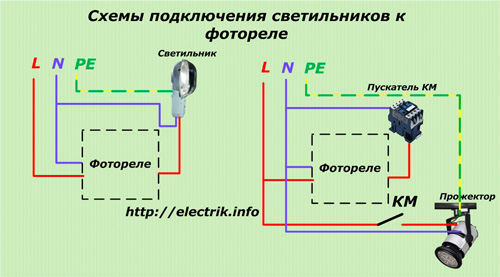Categories: Featured Articles » Home automation
Number of views: 30703
Comments on the article: 2
How to choose, configure and connect a photo relay for outdoor or indoor lighting
 At the beginning of the last century, in many cities there was a unique profession - a lamplighter. This was a man who was engaged in street lighting. With the onset of twilight, he lit lights every day, and in the morning extinguished them.
At the beginning of the last century, in many cities there was a unique profession - a lamplighter. This was a man who was engaged in street lighting. With the onset of twilight, he lit lights every day, and in the morning extinguished them.
Nowadays, automatic devices called “Twilight switches” or “photo relay”.
Appearance
Twilight switches are produced by manufacturers with various electrical characteristics, operational parameters and design for various purposes.
They can be created to work indoors, for example, to illuminate stairwells of porches or used outdoors under the influence of precipitation.
Operating principle
All photorelays are united by the fact that they work according to a single law, which the scheme below demonstrates.
The luminous flux of solar radiation is perceived by a special sensor that generates an electric current of a proportional value. When the illumination decreases, the value of the generated current decreases. Since the gallery is very small, it is amplified and fed to the relay - an actuator that combines the logical part in its design.
Relay contacts control the operation of luminaires or, if necessary, the starter for high-power spotlights.
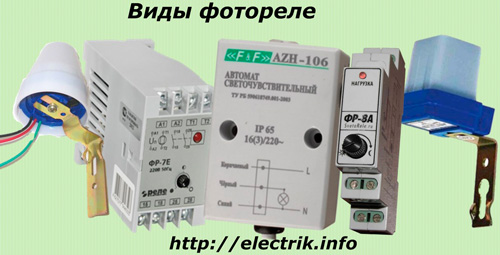
Photosensitive element can have a different device and work on the basis of:
-
a photoresistor that changes its electrical resistance under the influence of a light stream;
-
a photodiode that converts light into charges of electricity due to processes occurring in p-n junctions;
-
a phototransistor that converts light into the movement of electric charges as a result of electron-hole conduction;
-
photothyristor - an optoelectronic semiconductor device with a design resembling a conventional thyristor;
-
multi-layer photoimistor.
Photoresistor - This is a semiconductor product, which under the influence of a changing stream of light quanta proportionally converts its electrical resistance.

When a photoresistor is connected to a source of stabilized EMF through a load resistance R, a current dependent on lighting is established in the circuit.
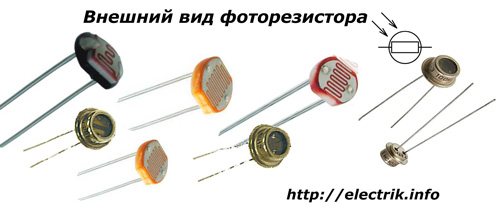
Photodiode converts light radiation into electric current and can work in circuits:
-
with applied external reverse voltage;
-
without him.
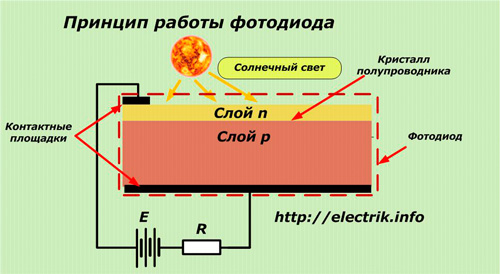
Phototransistor - This is an ordinary transistor that is sensitive to luminous flux. It can be made as a field or bipolar transistor with an n-p-n or p-n-p structure and a base that is irradiated with light. Changing the amount of illumination affects the value of the electric current in the connected circuit.
The sensitivity to light of phototransistors is higher than that of photodiodes. Therefore, their use is more promising.

Photo thyristor also works as an analog of a conventional thyristor, but it is controlled by the light flux and switches from a closed state to an open state (and vice versa) when the illumination reaches a certain threshold value.
The magnitude of the current passing through the control electrode, you can adjust the settings for the operation of the photo thyristor.

Photosemistor has a larger number of layers with electronic and hole conductivity, it is more difficult to manufacture. But it is also controlled by the stream of light incident on it, which irradiates one of the free semiconductor layers.
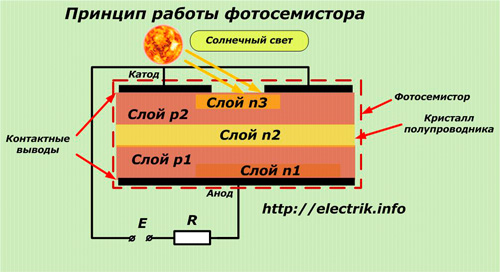
For more information about the arrangement of photosensors (photoresistors, photodiodes and phototransistors), see here: Photosensors and their application
Key Specifications
The choice of photo relay for various operating conditions is affected by:
-
sensitivity of the photocell to the light flux;
-
supply voltage;
-
power consumed by lighting devices;
-
working environment surrounding the twilight switch.
Sensitivity is determined by the ratio of the created photocurrent to the value of the light flux incident on the light element. It is measured in [μA / lm]. Since photocells react to light intensity and frequency, the sensitivity is divided into:
-
spectral associated with frequency;
-
integral, characterized by the intensity of the incident light flux.
Spectral photosensitivity It is used to evaluate the operation of the photocell at one specific frequency of light vibrations, for example, the invisible infrared region. Integral sensitivity is intended for analysis and operation of the total total light flux, which has spectra from the ultraviolet to the infrared part.
Rated voltage photorelay indicated in the documentation and on the housing of the device itself. Devices manufactured abroad may not be suitable for operation in the CIS countries due to other values of supply voltages adopted in different countries of the world.
Power of the lamps connected to the photo relay creates a load on the output contacts of the device, which can burn out in case of exceeding the permissible design values. Therefore, when choosing the design of a twilight switch, this question is always paid attention to.
In the case when a certain photo relay model, which is suitable for all parameters except the value of the connected load, you can use an additional device - a contactor or a starter, controlled by supplying voltage to its winding from the photo relay. In this case, the power contacts of the starter will reliably commute the load from powerful luminaires.
Ordinary twilight switches are designed to work with incandescent lamps that consume an active load. Luminescent and energy-saving light sources create additional reactive component, which limits the amount of power consumed. When using them, you should create a margin for the connected load.
The working environment in which the photo relay is located has a definite effect on its operation. For outdoor conditions, the twilight switch must be placed in a sealed enclosure that protects the electronics from rain, moisture, dust, and at low temperatures - additionally apply heating.
Devices operating in residential premises do not need such protection.
How to connect the photo relay to the lamps
Twilight Switch Installation Diagram usually applied on its body and is given in the manufacturer's documentation. Usually, three conductors are used to connect:
-
working zero network, used for photorelay and lamps simultaneously;
-
the phase that is fed to the input of the device;
-
potential wire coming out of the photorelay to the lamp.
The use of technologies of microprocessor devices for photorelay allowed equipping them with various functions that take into account specific operating conditions, for example, introducing motion sensors or a timer into the algorithm of their actions.
Schematically, the contacts of the timer and the motion sensor are shown with a series connection to the load, but for switching complex lighting circuits for expensive models, special algorithms that take into account specific tasks can be applied in the logic unit.
For example, the photo relay used for outdoor lighting can be detached from the response to headlights from cars passing by the device. This eliminates frequent tripping, increases the reliability of the device.
A motion sensor with a timer at the twilight switch installed in the entrance of a multi-storey residential building allows significant energy savings. Lamps are turned on when a person appears on any landing for a time sufficient to pass the stairs. Disabling them is automatic.
Setting photocell response parameters
For simple designs, all settings are set at the factory and are not adjustable during operation.
On advanced photocells, you can change:
-
sensitivity to the light flux incident on the photocell;
-
timer response time;
-
parameters for the operation of the motion sensor.
These parameters and their regulators are specified in the technical description.
Installation examples of common twilight switches
The 6 photos below clearly show how well three different electricians perform the same type of work. It should be noted that all the fixtures shown are controlled by twilight switches in different lighting conditions.
1. The photo relay above the entrance to a small shopping center is set beautifully.
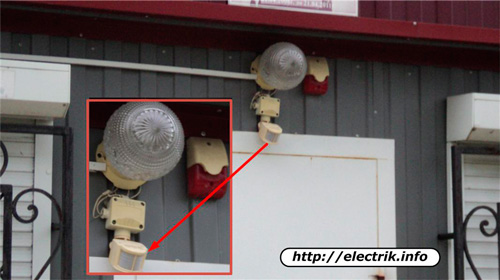
2. Installation of a lamp with a photo relay above the entrance door of a manufacturing enterprise.

3. Three versions of lighting with photo relay on different staircases of the same staircase, made by an electrician of housing and communal services.
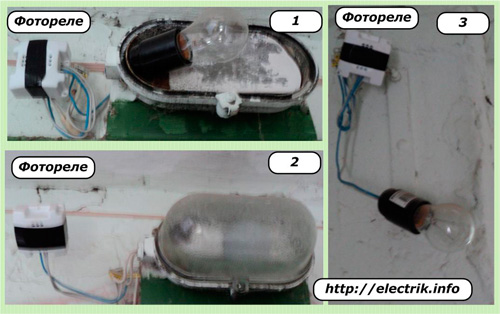
In conclusion, I want to ask a question, but what do you think about the work of such masters?
See also: How to make a simple photo relay yourself at home
P.S. This article is in PDF format:https://env.electricianexp.com/fotorele.pdf
See also at bgv.electricianexp.com
:


